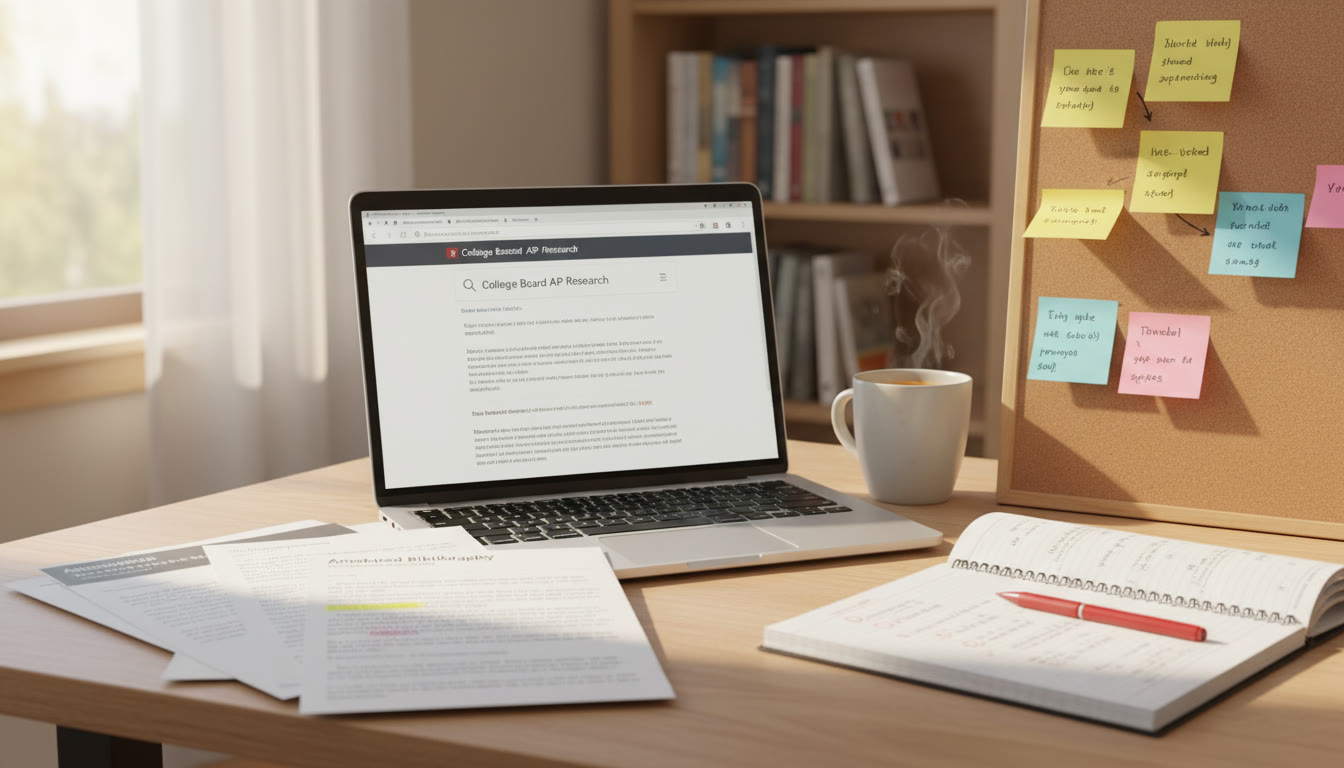Why an Annotated Bibliography Matters for AP Research
Think of an annotated bibliography as the heartbeat of your AP Research project. It’s not just a list of sources; it’s the place where your ideas meet evidence, where your curiosity gets organized, and where your future self (plus your teacher and the AP evaluators) can quickly understand the shape of your inquiry. Done well, annotations will sharpen your focus, reveal gaps in the literature, and provide a clear trail of intellectual choices that supports your academic argument.

What AP Research Expects (in plain language)
AP Research values original questions and careful, methodical study. The annotated bibliography supports this by documenting relevant literature and primary sources and by explaining — in a few concise sentences — why each source matters to your research question. Your annotations are evidence of critical thinking: you aren’t just collecting sources, you’re evaluating, synthesizing, and situating them.
Core Components of a Strong Annotation
An effective annotation balances description and evaluation. Aim for clarity and usefulness: someone who reads your bibliography should know what each source is, why you included it, and how you intend to use it.
- Full citation: Formatted consistently (APA, MLA, or the style your teacher requires).
- Summary (1–3 sentences): What is this source about? What are its main claims or findings?
- Evaluation (1–3 sentences): Is the source credible? What are its strengths, biases, or limitations?
- Relevance/use (1–3 sentences): How will this source serve your project? Does it inform your method, provide background, or offer contrasting evidence?
- Reflection (optional but powerful): How does the source change or confirm your thinking? What new questions does it raise?
Practical Templates to Write Annotations Fast (and Well)
Templates are a way to get unstuck. Use them to produce consistent, focused annotations that can later be edited for tone and nuance.
- Basic template: “This article argues X and finds Y. It is credible because A (method, author expertise, peer-review). It helps my research by B, and I will use it to support/challenge my claim that C.”
- Method-focused template: “This study uses [method] to examine [topic]. Key findings include X. Methodological strengths are Y; limitations are Z. I’ll model/adapt/contrast my method with this study by…”
- Theory-to-practice template: “This theoretical piece presents framework X. It’s useful for defining terms and framing analysis. I’ll apply its categories to interpret my data from…”
How to Choose Sources: Quality Over Quantity
You don’t win by having the longest bibliography. You win by having the most relevant, rigorous, and reflective one. Here’s a quick decision checklist for each potential source:
- Is the source directly related to your research question or methodology?
- Is it produced by a reputable author, institution, or journal?
- Does it add something unique — evidence, theory, or a perspective — that other sources don’t?
- Are there obvious biases or methodological issues? If so, does that make the source more or less useful?
Types of Sources to Balance
AP Research benefits from a mix: peer-reviewed journal articles, books, primary documents, high-quality reports, and sometimes relevant media pieces. Use primary sources when you’re doing original inquiry; use secondary sources to build context and show how your work connects to existing scholarship.
Time Management: Building Your Annotated Bibliography Without Panic
Good research planning turns a mountain of reading into manageable daily tasks. Here’s an example schedule you can adapt depending on your deadlines.
| Phase | Duration | Goal | Tasks |
|---|---|---|---|
| Exploration | 1–2 weeks | Find candidate sources | Search databases, skim abstracts, shortlist 12–20 items |
| Annotation Drafting | 2–3 weeks | Write annotations for shortlisted sources | Create 150–250 word annotations; refine using templates |
| Integration | 1 week | Use annotations to refine question/method | Identify gaps; add sources to fill them |
| Polish | 3–5 days | Finalize format and edit | Consistent citation style; proofread; ensure annotations are concise |
Annotating Strategically: Not All Notes Are Equal
When you read, record notes that directly feed your annotation categories. Use a two-column method: left column for quotes, data, and page numbers; right column for quick thoughts — why it matters, how you might use it, and any lingering questions. That right column becomes gold when you write the annotation.
Digital Tools and Organization
Whether you prefer sticky notes or a reference manager, the key is retrieval. Tools let you tag sources (e.g., “method”, “background”, “counterargument”). But tool choice doesn’t matter as much as consistent habits: name files clearly, keep citation metadata complete, and tag aggressively.
Common Pitfalls Students Make (and How to Avoid Them)
- Too much summary, too little evaluation: Don’t treat an annotation like an abstract. Always add a line evaluating trustworthiness and relevance.
- Vague relevance statements: Replace “useful for my paper” with specifics: “This dataset will let me compare X and Y because…”
- Inconsistent citation style: Set your style at the start and stick to it. Messy formatting distracts from good scholarship.
- Leaving annotations until the end: Writing annotations as you go creates a living map of your thinking; waiting makes the work harder.
How Annotations Shape Your AP Research Argument
Annotations aren’t just documentation; they’re scaffolding. As you write annotations you will:
- Identify theoretical frameworks to borrow or critique.
- Spot methodological approaches to emulate or avoid.
- Discover contradictions that can become the heart of your analysis.
These outcomes tighten your research question and ensure your final product demonstrates command over both content and context — exactly what AP Research scorers want to see.
Example Annotation (Short, Clear, Model)
Use this model as a blueprint for length and structure.
Smith, J. (2020). Title of Study. Journal of Educational Inquiry, 12(3), 45–62.
Summary: Smith investigates the relationship between formative feedback and student revision practices in high school biology classrooms, using mixed methods. Key findings indicate that specific, criterion-referenced feedback increases substantive revisions more than general comments.
Evaluation: Peer-reviewed study with robust sampling (n=12 classrooms) and clear coding procedures. Limitations include regional sampling and potential observer bias.
Relevance: This study offers a method I can adapt for coding revision types in my own research and provides an empirical basis for expecting certain outcomes when feedback is present.
How Sparkl’s Personalized Tutoring Can Help (When It Fits Naturally)
Preparing an annotated bibliography is a mix of intellectual judgment and disciplined process. For many students, a short sequence of targeted coaching accelerates that learning curve. Sparkl offers 1-on-1 guidance and tailored study plans that can help you choose high-quality sources, practice writing concise evaluations, and receive feedback on draft annotations. Sparkl’s expert tutors can model the annotation process and suggest AI-driven insights to highlight gaps in your literature review—especially helpful if your topic spans multiple disciplines.
When to Ask for Help
- If you’re unsure how to evaluate methodological rigor.
- If you can’t find primary sources for your question.
- If you want a faster route to a clear, defensible research question.
Bringing It Together: From Bibliography to Final Project
Once your annotated bibliography is solid, use it as a blueprint for the remainder of your AP Research project. Map each annotation to sections of your paper: background, method justification, literature gap, and discussion. This ensures that your literature review isn’t an isolated chapter but an integrated set of claims that your research addresses.
Quick Checklist Before Submission
- Consistent citation style and formatting.
- Each annotation includes summary, evaluation, and relevance.
- Sources represent a balance of primary and secondary evidence.
- No annotation is simply a duplicated abstract — each includes your critical voice.
- Gaps identified; plan to fill them or explain limitations.

Mini Case Study: How an Annotated Bibliography Changed a Project
Anna, an AP Research student, began with a broad question about social media and civic engagement. Her first annotated bibliography drafts were a collection of loosely related articles: surveys, opinion pieces, and a few academic studies. As she annotated, patterns emerged: most large-scale surveys focused on frequency of use, whereas a handful of qualitative studies explored motivation and civic identity. By evaluating methodology and relevance in her annotations, Anna refined her question to focus on motivational factors among first-time voters, targeted a mixed-methods approach, and designed interview protocols that directly responded to methodological gaps she’d recorded. The annotated bibliography had become both map and engine of her project—a living document that shaped data collection and analysis.
Final Encouragements: Mindset and Style
Annotated bibliographies reward curiosity and clarity. Approach them with the same ethic you bring to good writing: be precise, be honest about limitations, and treat each annotation as a mini-argument. If you’re feeling stuck, remember that research is iterative. Revisit sources, revise annotations, and let your bibliography evolve alongside your thinking. When appropriate, short sessions with a skilled tutor—like those offered by Sparkl—can accelerate progress by focusing feedback and modeling scholarly judgment.
Parting Tips: Quick Do’s and Don’ts
- Do write annotations as you read; don’t postpone them until the end.
- Do be specific about how a source will be used; don’t leave vague promises.
- Do track citation metadata meticulously; don’t rely on memory for page numbers or DOIs.
- Do reflect on how each source shifts your thinking; don’t treat annotations as administrative chores.
Annotated bibliographies are more than paperwork — they are a strategic practice that reveals, refines, and supports your AP Research project. Start early, stay organized, and let each annotation bring new clarity to your inquiry. With consistent effort, thoughtful evaluation, and targeted support when needed, your bibliography will do far more than document what you read: it will power a better, more persuasive research project.
Good luck — and remember: quality over quantity, a clear critical voice, and a plan for integration will make your annotated bibliography a centerpiece of your AP Research success.



















No Comments
Leave a comment Cancel